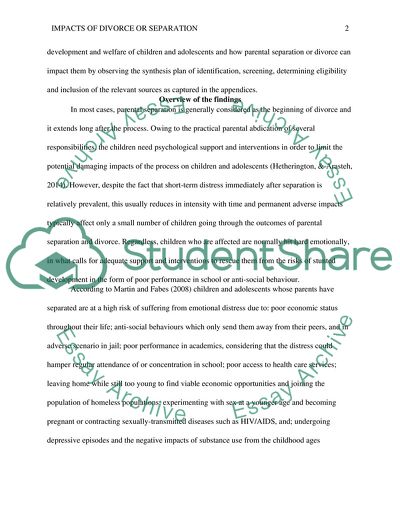Cite this document
(Negative Impacts of Separation or Divorce on Children and Adolescents Literature review Example | Topics and Well Written Essays - 3000 words, n.d.)
Negative Impacts of Separation or Divorce on Children and Adolescents Literature review Example | Topics and Well Written Essays - 3000 words. https://studentshare.org/psychology/1870799-what-evidence-is-there-to-support-the-assumption-that-parental-separation-or-divorce-has-a-negative-impact-upon-child-and-adolescent-development
Negative Impacts of Separation or Divorce on Children and Adolescents Literature review Example | Topics and Well Written Essays - 3000 words. https://studentshare.org/psychology/1870799-what-evidence-is-there-to-support-the-assumption-that-parental-separation-or-divorce-has-a-negative-impact-upon-child-and-adolescent-development
(Negative Impacts of Separation or Divorce on Children and Adolescents Literature Review Example | Topics and Well Written Essays - 3000 Words)
Negative Impacts of Separation or Divorce on Children and Adolescents Literature Review Example | Topics and Well Written Essays - 3000 Words. https://studentshare.org/psychology/1870799-what-evidence-is-there-to-support-the-assumption-that-parental-separation-or-divorce-has-a-negative-impact-upon-child-and-adolescent-development.
Negative Impacts of Separation or Divorce on Children and Adolescents Literature Review Example | Topics and Well Written Essays - 3000 Words. https://studentshare.org/psychology/1870799-what-evidence-is-there-to-support-the-assumption-that-parental-separation-or-divorce-has-a-negative-impact-upon-child-and-adolescent-development.
“Negative Impacts of Separation or Divorce on Children and Adolescents Literature Review Example | Topics and Well Written Essays - 3000 Words”. https://studentshare.org/psychology/1870799-what-evidence-is-there-to-support-the-assumption-that-parental-separation-or-divorce-has-a-negative-impact-upon-child-and-adolescent-development.


